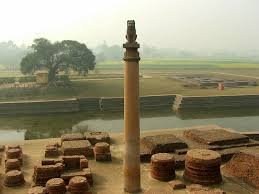The story of the Mauryan Empire is one of ambition, brilliance, and eventual decline. Spanning the Indian subcontinent and thriving between 321 BCE and 185 BCE, the Mauryan Empire laid the groundwork for governance, economy, and culture in South Asia. Let’s dive into this fascinating journey to explore its meteoric rise and inevitable fall.

The Humble Beginnings
Before the Mauryan Empire took shape, India was a patchwork of kingdoms. The Nanda Dynasty ruled over much of northern India, but their oppressive taxation and autocratic governance sowed the seeds of discontent. This set the stage for a young, ambitious leader: Chandragupta Maurya.
Chandragupta Maurya: The Architect of an Empire
Chandragupta, mentored by the brilliant strategist Chanakya (also known as Kautilya), overthrew the Nandas around 321 BCE. Chanakya’s political treatise, the Arthashastra, became the blueprint for establishing and managing the empire. Together, they carved out an expansive dominion, uniting much of the Indian subcontinent under a single administration for the first time.
The Golden Age: Ashoka the Great
While Chandragupta laid the foundation, it was his grandson Ashoka who elevated the Mauryan Empire to unparalleled heights. His reign marked the zenith of Mauryan power and influence.
Early Reign and the Battle of Kalinga
Ashoka ascended the throne in 268 BCE. Initially, his rule was marked by conquests, the most significant being the bloody Battle of Kalinga. The aftermath of this war, which resulted in massive casualties, profoundly transformed Ashoka.
Embracing Buddhism
Deeply moved by the suffering caused by the war, Ashoka embraced Buddhism and renounced violence. His reign shifted focus to peace, welfare, and the propagation of Buddhist principles. He constructed stupas, pillars, and inscriptions that spread messages of morality, tolerance, and non-violence across his empire and beyond.
Administrative Brilliance
The Mauryan administration was a marvel of its time. It was highly centralized, with a structured bureaucracy and an emphasis on efficient governance.
Provincial Governance
The empire was divided into provinces, each governed by a royal prince or trusted official. This ensured effective management of the vast territory.
Revenue System
A sophisticated taxation system funded public works and maintained a strong military. Land revenue, trade duties, and tributes formed the backbone of the empire’s economy.
Infrastructure Development
Under the Mauryas, infrastructure flourished. Roads, irrigation systems, and trade routes connected distant parts of the empire, fostering economic growth and cultural exchange.
The Role of Religion and Culture
The Mauryan Empire was a melting pot of ideas and beliefs. While Hinduism remained prevalent, Buddhism gained immense patronage under Ashoka.
Spread of Buddhism
Ashoka’s efforts to spread Buddhism were remarkable. He dispatched emissaries to regions as far as Greece, Egypt, and Southeast Asia, making Buddhism a global religion.
Art and Architecture
Mauryan art, characterized by the famous Ashokan pillars and rock-cut caves, reflected a fusion of indigenous and external influences. These creations symbolized both power and spirituality.
See What Eating Egg Will do to your Body: A Nutritional Powerhouse
The Decline Begins
Empires are seldom eternal, and the Mauryan Empire was no exception. After Ashoka’s death in 232 BCE, the empire’s decline began.
Weak Successors
Ashoka’s successors lacked his vision and leadership qualities. Internal dissent and weak governance eroded the central authority.
Economic Strain
The vast empire’s maintenance put immense pressure on its resources. With declining revenues and increasing expenditures, the administration struggled to keep the machinery running.
Foreign Invasions
The northwestern frontiers faced repeated invasions from Indo-Greeks and other foreign powers. These incursions further weakened the empire’s control over its territories.
The Final Fall
The last Mauryan ruler, Brihadratha, was overthrown by his commander-in-chief, Pushyamitra Shunga, in 185 BCE. This marked the end of the Mauryan dynasty and the rise of the Shunga Empire.
The Legacy of the Mauryan Empire
Despite its decline, the Mauryan Empire left an indelible mark on Indian history.
Political Unity
For the first time, a large portion of the Indian subcontinent experienced political unification under a centralized authority.
Influence on Governance
The administrative systems and policies implemented by the Mauryas influenced subsequent Indian dynasties and even modern governance.
Cultural Contributions
The Mauryas fostered art, architecture, and religious thought that continue to inspire generations. The dissemination of Buddhism, in particular, shaped the cultural and spiritual landscape of Asia.
Conclusion
The Mauryan Empire’s story is one of ambition, innovation, and transformation. While its fall serves as a reminder of the impermanence of empires, its legacy endures in the form of cultural and political advancements that resonate to this day. From Chandragupta’s audacity to Ashoka’s compassion, the Mauryan saga is a testament to the heights humanity can achieve and the lessons history offers.
The Anti-Apartheid Movement in South Africa: A Fight for Freedom and Justice
FAQs
1. Who founded the Mauryan Empire?
Chandragupta Maurya, with the guidance of Chanakya, founded the Mauryan Empire in 321 BCE by overthrowing the Nanda Dynasty.
2. Why is Ashoka considered a great ruler?
Ashoka is celebrated for his transformative leadership, embracing Buddhism, and promoting peace and welfare after the Battle of Kalinga.
3. What led to the decline of the Mauryan Empire?
The decline was due to weak successors, economic strain, and foreign invasions, culminating in the assassination of the last ruler, Brihadratha.
4. What was the significance of the Battle of Kalinga?
The Battle of Kalinga marked a turning point in Ashoka’s reign, leading him to embrace non-violence and Buddhism, influencing his policies and governance.
5. How did the Mauryan Empire contribute to art and culture?
The Mauryan Empire fostered art and architecture, including the iconic Ashokan pillars and stupas, and played a pivotal role in spreading Buddhism across Asia.


